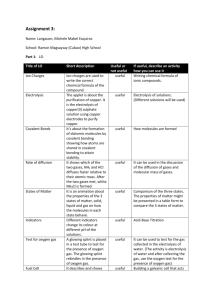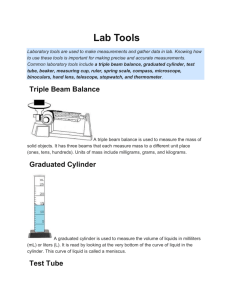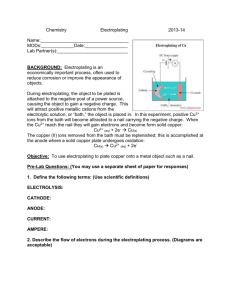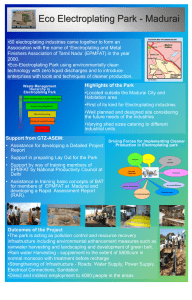CHEMICAL EFFECTS OF ELECTRIC CURRENT Q2. When the free
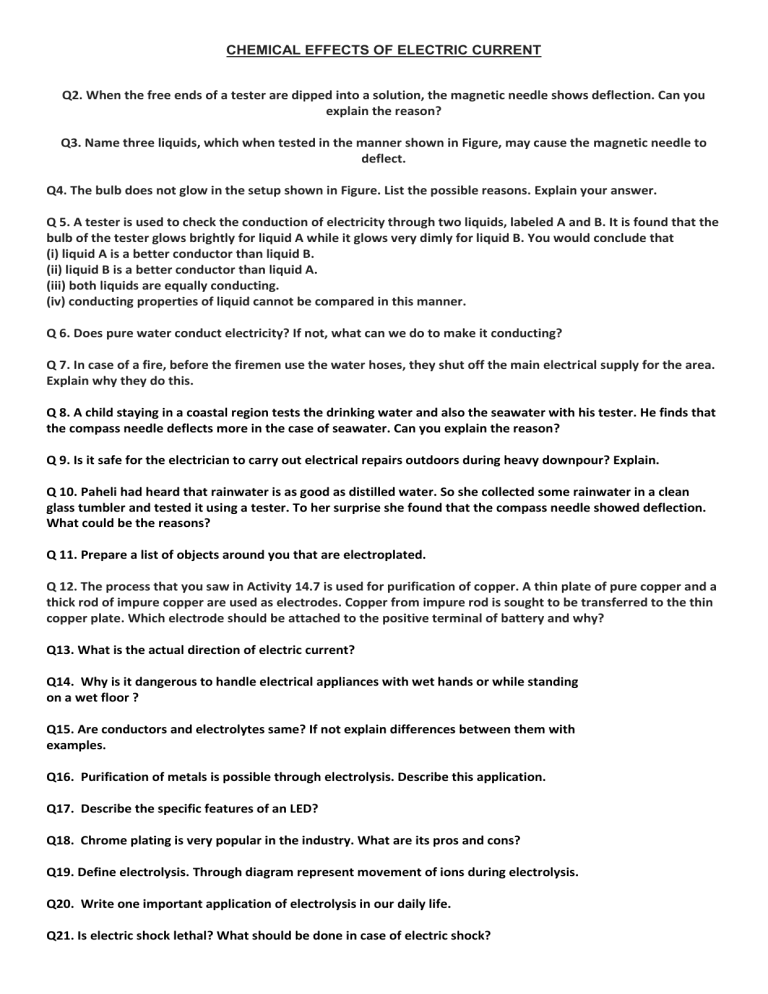
CHEMICAL EFFECTS OF ELECTRIC CURRENT
Q2. When the free ends of a tester are dipped into a solution, the magnetic needle shows deflection. Can you explain the reason?
Q3. Name three liquids, which when tested in the manner shown in Figure, may cause the magnetic needle to deflect.
Q4. The bulb does not glow in the setup shown in Figure. List the possible reasons. Explain your answer.
Q 5. A tester is used to check the conduction of electricity through two liquids, labeled A and B. It is found that the bulb of the tester glows brightly for liquid A while it glows very dimly for liquid B. You would conclude that
(i) liquid A is a better conductor than liquid B.
(ii) liquid B is a better conductor than liquid A.
(iii) both liquids are equally conducting.
(iv) conducting properties of liquid cannot be compared in this manner.
Q 6. Does pure water conduct electricity? If not, what can we do to make it conducting?
Q 7. In case of a fire, before the firemen use the water hoses, they shut off the main electrical supply for the area.
Explain why they do this.
Q 8. A child staying in a coastal region tests the drinking water and also the seawater with his tester. He finds that the compass needle deflects more in the case of seawater. Can you explain the reason?
Q 9. Is it safe for the electrician to carry out electrical repairs outdoors during heavy downpour? Explain.
Q 10. Paheli had heard that rainwater is as good as distilled water. So she collected some rainwater in a clean glass tumbler and tested it using a tester. To her surprise she found that the compass needle showed deflection.
What could be the reasons?
Q 11. Prepare a list of objects around you that are electroplated.
Q 12. The process that you saw in Activity 14.7 is used for purification of copper. A thin plate of pure copper and a thick rod of impure copper are used as electrodes. Copper from impure rod is sought to be transferred to the thin copper plate. Which electrode should be attached to the positive terminal of battery and why?
Q13. What is the actual direction of electric current?
Q14. Why is it dangerous to handle electrical appliances with wet hands or while standing on a wet floor ?
Q15. Are conductors and electrolytes same? If not explain differences between them with examples.
Q16. Purification of metals is possible through electrolysis. Describe this application.
Q17. Describe the specific features of an LED?
Q18. Chrome plating is very popular in the industry. What are its pros and cons?
Q19. Define electrolysis. Through diagram represent movement of ions during electrolysis.
Q20. Write one important application of electrolysis in our daily life.
Q21. Is electric shock lethal? What should be done in case of electric shock?
Q22. What is deplating? How is it useful?
Q23. Do liquids also conduct electricity? Name two liquids which conduct electricity and two liquids which do not conduct electricity.
Q24. Name a device which glows even when a weak electric current passes through it.
Q25.What is electrochemistry?
Q26. Which effect of electric current is utilized for detecting the flow of current through a solution: a) When a torch bulb is used? (b) When a compass is used?
Q27. Is it safe for the electrician to carry out electrical repairs outdoors during heavy downpour? .
Q28. When electric current is passed through acidified water, then hydrogen and oxygen are formed. What type of effect of current is illustrated by this statement?
Q29. State some of the characteristics of chemical changes brought about by the chemical effect of electric current.
Q30. Name the metal which is usually electroplated on car parts such as bumpers and bicycle handlebars made of steel.
Q31. An iron key is to be electroplated with copper. Draw a labeled sketch of the experimental set up used for this purpose.
Q32. Name two metals which are usually electroplated on cheaper metals for making jewellery (or ornaments).
Q33. You are required to do electroplating of copper on an iron object. Name the positive electrode (anode) and the electrolyte you will use for this purpose.
Q34. During electroplating the copper deposited on the plate connected to negative terminal comes from the solution. How this loss of copper from solution compensated?
Q35. Why does compass needle show more deflection when you test sea water, compared to ordinary water?
Q36. Describe electrolysis of water?
Q37. What happens to the needle of a magnetic compass kept nearby when electric current is switched on in a wire? Why does this happen?
Q38 Iron is used in bridges and automobile to provide strength. Which metal is electroplated on iron to protect it from corrosion?
Q39. We should never handle electrical appliances with wet hands or while standing on a wet floor. Why?
Q40. When the free ends of a conductivity tester (made by using a battery connected to a wire wound around a compass) are dipped into the following solution, then in which solution or solutions the compass needle shows deflection.
Solutions are: Lemon juice, Vinegar, Tap water, Vegetable oil, milk, Honey.
Q41.Why does an electric bulb glow when a current passes through it?
Q42: What are conductors?
Q43: What are insulators?
Q44: Are liquids conductors of electricity?
Q45: What are the metal rods dipped in liquids to which cells are attached called?
Q46: When we pass current through a conducting solution of water, which gas bubbles will appear near positively charged electrodes?
Q47: Name any chemical effect of electric current.
Q48: To which terminal of the battery the metal meant for electroplating is attached?
Q49: In which direction does current flow?
Q50: Which gas will accumulate near negative electrode when electric current is passed through a conducting solution of water?
Q51: What is LED, why is it the most preferable source of electricity?
Q52: How can you prove conducting properties of substances when the current is very small and bulb does not glow?
Q53: What is ‘Electroplating’? Describe.
Q54: Give some advantages of electroplating.
Q55: What do you mean by electroplating?
Q56 (MCQ): Iron is galvanized by coating with__________________.
(a) nickel
(b) tin
(c) zinc
(d) copper
Q57 Name the scientist who showed electrolysis of water.
Q58 Why are Tin cans used for storing food?
Q59 Which type of energy is converted into electrical energy in an electric cell?
